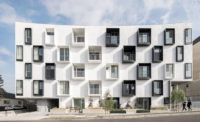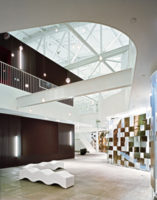Formosa 1140
West Hollywood, California

Photo © Lawrence Anderson Photography

Photo © Lawrence Anderson Photography

Photo © Lawrence Anderson Photography

Photo © Lawrence Anderson Photography

Photo © Lawrence Anderson Photography

Image courtesy Lorcan O'Herlihy Architects

Image courtesy Lorcan O'Herlihy Architects

Image courtesy Lorcan O'Herlihy Architects

Image courtesy Lorcan O'Herlihy Architects









Architects & Firms
Southern California may conjure images of patios, barbecue grills, and al fresco dining, but outdoor spaces there tend to be private — either tucked behind houses or confined to internal courtyards in apartment complexes. “L.A. is a privatized city,” states Lorcan O’Herlihy, FAIA, whose firm designed Formosa 1140, an 11-unit condominium on North Formosa Avenue in West Hollywood. “New York has a lot more public open space than we do,” adds the Los Angeles—based architect. So O’Herlihy and developer Richard Loring used this project as an opportunity to combine private property and the public realm, enhancing both in the process.
Program
From the start, Loring and his company, Habitat Group, saw the advantages of breaking down the traditional boundary between public and private. Instead of creating a series of small backyards or an internalized courtyard for the residential complex, he and O’Herlihy wanted to establish a larger outdoor space that could be used by the public as well as condo residents. This larger space would add value to the dwelling units while serving as a public amenity for the entire neighborhood.
The developer and architect aimed the complex at young professionals, offering two- and three-bedroom duplex units ranging from about 1,400 to 1,700 square feet. Having worked together on two previous housing projects in West Hollywood, Loring and O’Herlihy had developed a relationship that allowed good ideas to flow back and forth. They had also established a good relationship with the city of West Hollywood, which agreed to provide loan guarantees and small variances to building-envelope regulations in exchange for a public park on part of the site.
Solution
By pushing the apartment building to one side, O’Herlihy was able to create a pocket park on one third of the 13,800-square-foot site. “The challenge was providing enough open space to make the park really useful while fitting 11 units on the property,” says O’Herlihy. The architect solved the problem by orienting the narrow end of the building to the street and the long end to the park. Underneath the park, he tucked a concrete garage with space for 23 cars.
“From the beginning, the park informed the design of the building,” explains O’Herlihy. Although the building has a simple rectangular footprint to keep construction costs down, balconies and windows project outward in various places to engage the landscape and animate the major facades. Outdoor corridors on the first and third floors overlook the park, providing access to the apartments and serving as a buffer for the units inside.
In addition to overlooking the park, each dwelling unit has its own small outdoor space: balconies facing the park or street for the lower apartments and mostly roof decks for the upper units. The architects provide solar and visual protection for the homes with a series of orange or red corrugated-steel panels — some oriented vertically, some horizontally, some perforated, and some solid. “We wanted to create a layering of screens and skins,” says O’Herlihy. Although he didn’t use any alternative energy sources or high-tech energy-saving devices, the architect kept the building’s footprint small to encourage cross ventilation.
To limit construction costs to roughly $5 million, the architects designed a simple, wood-frame building with just three different apartment layouts. All of the units are duplexes and most have a “flex” room on the lower floor that can serve as either a study or a third bedroom. (Units facing the street are a bit smaller and have just two bedrooms.) A simple palette of colors (mostly white with orange or red accents) and few partitions (only a curtain separates the master bedroom from its bathroom, for example) make the apartments feel open and contemporary.
Commentary
Inspired by the bright colors of the nearby Formosa café — a favorite Hollywood hangout — O’Herlihy and his associates brought a hipster’s vibe to midmarket housing that too often feels stale and formulaic. They also did a good job of using simple materials in a variety of ways to create a feeling of depth and animation on the two major facades. While the floor plans and interiors don’t break any new design ground, they certainly provide attractive, well-lighted spaces for modern living.
O’Herlihy’s claims of “contesting the boundaries between public and private” may be a bit overstated, but Formosa 1140’s inclusion of a public park certainly encourages a type of urbanism that is rare in cities like Los Angeles. If we’re lucky, it will serve as a model for developers to give back to their communities.
Completion Date: January 2009
Gross square footage: 16,000 sq. ft.
Total construction cost: $5 million
Owner: Richard Loring, President (Habitat Group Los Angeles, LLC)
Architect:
Lorcan O’Herlihy Architects (LOHA)
5709 Mesmer Avenue
Culver City, CA 90230
Ph 310.398.0394
F 310.398.2675















